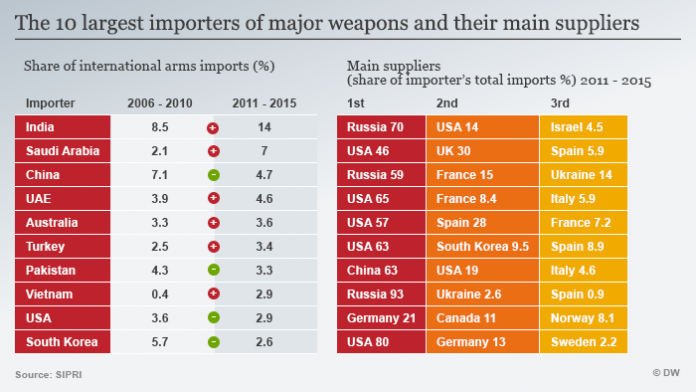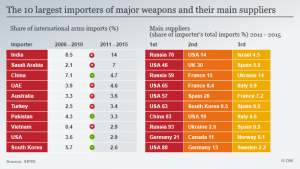According to a report released by Stockholm International Peace Research Institute (SIPRI) on February 20, 2017, India emerged as the world’s largest importer of major arms during 2012–16.
- As per the report, India accounted for 13 percent of the global total sales.The total volume of international transfers of major weapons has grown continuously since 2004 and increased by 8.4 per cent between 2007–11 and 2012–16
Key Highlight of the Report
According to the data, in Asia, India increased its arms imports by 43 percent between 2007–11 and 2012–16 which is far greater than the imports by its rivals China and Pakistan.
- Between 2007 and 2011, India accounted for 9.7% of global imports which is still more than any other country.
- Major arm suppliers to India include Russia, USA, European states, Israel and South Korea.

- The report said that India faces serious geopolitical threats from its nuclear-armed rival Pakistan and China’s rising military strength.
- Though the ‘Make in India’ program has been launched by the Indian government to encourage local arms production, India’s domestic defence sector is not capable of meeting growing requirements.
- vi.They spend a lot of time and money trying to develop weapons in India and things just go hopelessly wrong. This leaves India dependent on foreign imports
- The report stated that the increase in the import of arms was driven by high demand especially in Middle East and Asia. In South East Asia, the imports grew up by 6.2 percent from 2007–11 to 2012–16.
- In Middle East, during 2012–16, Saudi Arabia was the largest importer of arms and increased by 212 percent compared with the previous five years. It accounted for 8.2 percent of global arms imports.
- Qatar arms import went up by 245 percent during the period.
- As per the report, Middle East doubled its imports. Between 2007–11 and 2012–16 arms imports by states in the region rose by 86 percent and accounted for 29 percent of global imports in 2012–16.
- Besides, Vietnam was another in South East Asia that made a big jump with its arm imports increasing 202 percent in 2012-16. It was the 10th largest importer in South Asia. Vietnam was the 29th largest importer in 2007-2011.
- The repost said that while China is increasingly adopting indigenous products as a substitute of arms imports, India is still dependent on weapons technology.
- China’s share of global defence imports fell to 4.5 percent of the global total between 2012 and 2016 from 5.5 percent between 2007 and 2011.
- Among the African region, Algeria was the largest importer across Africa while in the sub-Saharan Africa Nigeria, Sudan and Ethiopia were all the leading importers of arms.
Largest Exporters According to the Report
Among the leading exporters of arms, the United States of America was the top arms exporter in the world which increased its exports by 21 percent compared with 2007–11.
- Out of the total exports made by USA almost half of its arms exports was made to the Middle East.
- Russia was placed as the second largest exporter that increased its exports by 23 percent selling its arms to four countries of India, Vietnam, China and Algeria.
- China also increased its sale of arm exports which supplies to France and Germany.
- The report also found that the only country which cut down on its arms exports is Germany which over a five-year period decreased its exports by 36 percent between 2007–11 and 2012–16.
- The five biggest exporters, the United States, Russia, China, France and Germany, together accounted for 74 per cent of the total volume of arms exports.
About Stockholm International Peace Research Institute (SIPRI)
SIPRI is an international institute in Sweden, that deals with research work into conflict, armaments, arms control and disarmament.
- SIPRI provides data, analysis and recommendations based on open sources to policymakers, researchers, media and the interested public.
- The SIPRI Arms Transfers Database contains information on all international transfers of major weapons including sales, gifts and production licences to states, international organizations and armed non-state groups from 1950 to the most recent full calendar year, 2016.
- SIPRI data reflects the volume of deliveries of arms and not the financial value of the deals.
- As the volume of deliveries can fluctuate significantly year-on-year, SIPRI presents data for 5-year periods, giving a more stable measure of trends.






